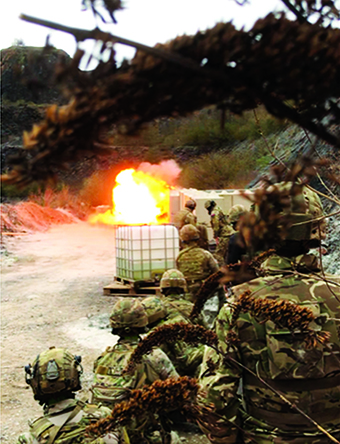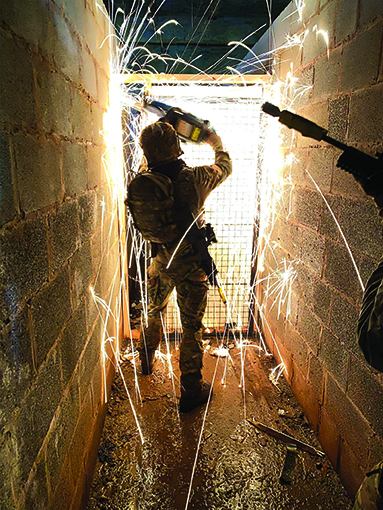The following article is taken from the March/April issue of the Globe & Laurel magazine.
Click the button below to discover more.

by Sgt N Ironmonger, AE1 Assault Engineer Instructor

‘Any problem on earth can be solved by the careful application of high explosive.’
The statement, taken from the feature film ‘Valkyrie’, is maybe a little ambitious, as students arriving on the Combat Assault Breacher (CAB) Course soon realise. The course replaced the Assault Engineer Class 3 (AE3) course in early 2020 and provides the Corps with its own organic DENY/DEFEND capability via the application of a wide variety of skills, including Demolitions, Counter-Explosive Ordnance (C-EO), Sabotage and Assault Breaching amongst others.
To start, and before any student’s ‘problems’ can be solved through the careful application of high explosives, it takes a great deal of mental and physical effort to learn and understand demolition theory, solve mathematical problems and complete inert training. After furious scribbling of notes, assessments and examinations, and the occasional look of deep concern, successful students will progress onto week two and be allowed to conduct live demolitions – otherwise known as the ‘fun’ part.
Those who prefer a ‘hands-on’ approach are finally given their chance to shine and put theory into practice by carefully calculating the amount of explosives required before constructing their charge. Following an instructor’s nod of approval (which is, thankfully, given more often than not) the charges are ready to be initiated and with the call of ‘Firing now!’, a mix of topsoil and targets is launched skywards, signifying a job well done.
Week three has students conducting C-EO and ‘precision destruction’ or sabotage. During C-EO, students are taught the skills necessary to detect, identify and destroy explosive ordnance to maintain mobility and reduce the risk to their oppos. As an instructor, it’s entertaining to see just how competitive this module becomes, with students convinced that they’ll find, not only their intended target, but also some form of ancient treasure buried within the confines of CTCRM. Theory and practical lessons and a visit to the Defence Academy, Shrivenham finish off the week and give students the knowledge to deny friendly or sabotage adversary targets.
Week four focuses on Method of Entry (MoE) and covers manual, mechanical, ballistic, explosive, thermal and hydraulic theory and techniques. This module also includes Heavy Breaching when students learn the specialist methods to attack and breach walls, reinforced concrete and other obstacles.
The fifth and last week of the course has the students put all of their recently acquired knowledge to the test through multiple day and low light serials. Tactical evaluations become increasingly complex and are used to assess students and add intensity to their training.

Ensuring that they ‘only blow the bloody doors off’, this phase consolidates all the MoE skills taught into one condensed, and often overwhelming, 20-minute period of controlled chaos. Each student must decide the best course of action and choose and execute their method(s) of attack, under pressure with limited time to create a successful breach.
Finally, before any opportunity to relax and reflect on the course, students are then issued with orders for their final objective which involves an assault onto Broadmead Quarry. With ‘assistance’ from the Mountain Leader Section, the serial includes multiple breaches and target denials in the face of a determined enemy. After a ‘leisurely jog’ to the top of the quarry on completion, students can eventually set their equipment down and be content in the knowledge that they’ve done all that is required to become a Combat Assault Breacher.
Read more from the Journal of the Royal Marines
For more information, and to read similar stories, visit: Globe & Laurel – RMA – The Royal Marines Charity (rma-trmc.org)
